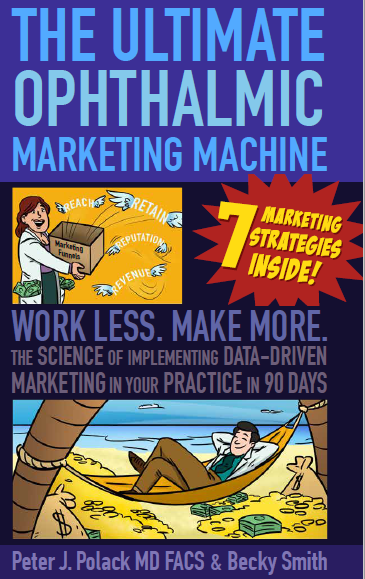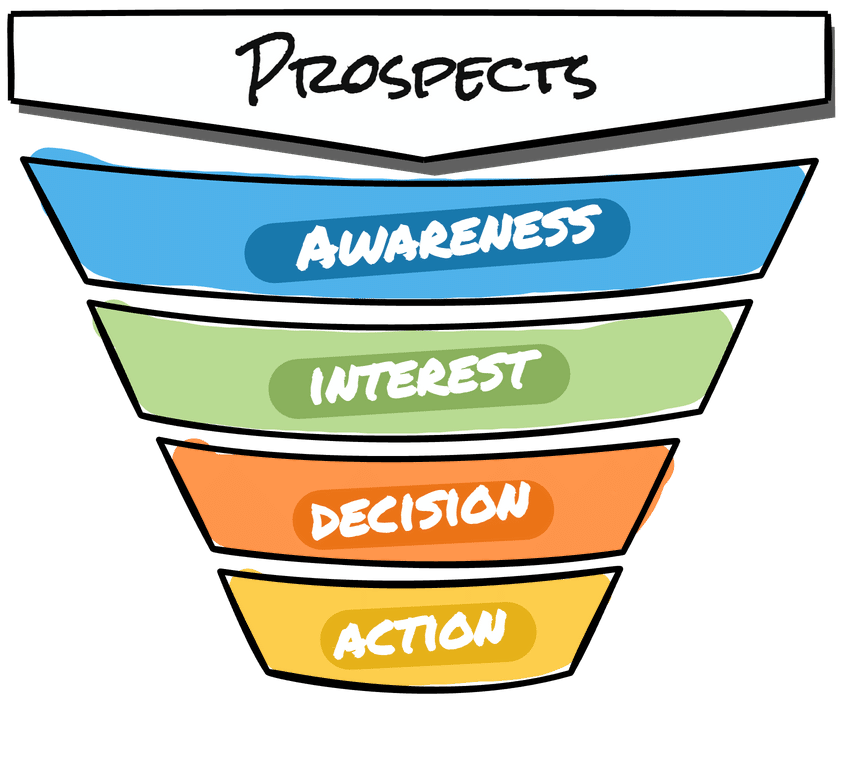
First: You Must Visualize Your Patients’ Buying Journey if You Want to Improve Conversions
Most of us assume if we just make a prospective patient an offer for a service or procedure - like new bifocal contact lenses or the latest dry eye treatment - that they will just jump at the chance, right?
There are two problems with this assertion:
How many prospects turned down your offer - via ad or Facebook post, etc. - without you even being aware of it?
At what point did they decide that your service or procedure was NOT for them?
Unless you are carefully tracking every single person who lays eyes on your offer, you only know how many DID take you up on your offer, not the ones who walked away.
The most effective marketers (yes, you are a marketer of your business) map out their marketing process from first impression to sale using what is known as a marketing funnel. In this manner, they are able to constantly tweak how, when, where and to whom their offer is made. Once they have this, they can continually improve their sales conversions.
What is a Marketing Funnel?
A marketing funnel is a representation of all of the steps that a prospect takes on their path to purchasing from your practice. There are many iterations of marketing funnels, one of the simplest being an AIDA funnel, for Awareness (or Attention), Interest, Decision (or Desire), and Action (from clicking a button to placing a phone call to, ideally, making an actual purchase).

'AIDA' Marketing Funnel
This is actually a good one to start with because it demonstrates that there is more to marketing than just awareness. Unfortunately, awareness - in the form of social media and content marketing - is typically where a marketing agency will tell you to spend a large portion of your budget (after you’ve already purchased advertising and marketing services from them). They point to the success of a social awareness effort in terms of ‘clicks and likes.’ But without some sort of action that moves the sale, awareness and interest (also known as engagement) are just a bunch of activity.
As marketing guru Andre Chaperon points out, Awareness and Engagement without Conversion to a sale is not a business. In fact, take any of the three circles away and the central triangle representing the business disappears (go ahead, try it!).
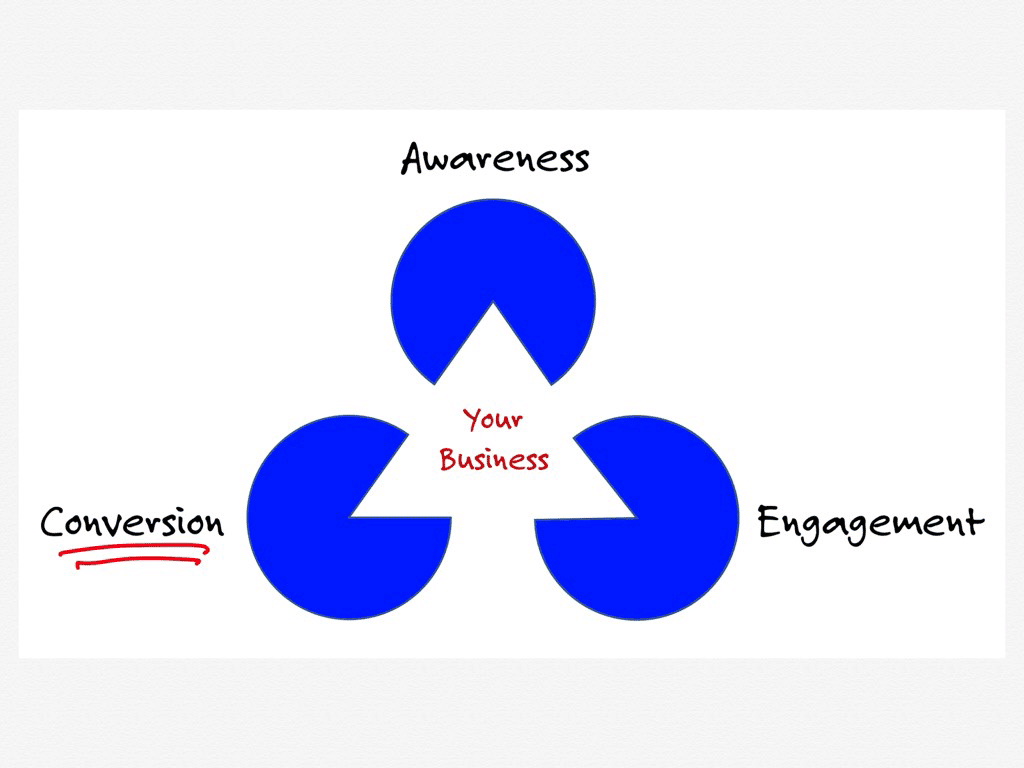
You use marketing funnels to define what is known as the ‘customer’s buying journey’. Here I explain how visually mapping your practice marketing funnels can identify constraints, dependencies, and black holes where your advertising money gets wasted, and at the same time you’ll be potentially increasing conversions.
Our first funnel was developed to stop LASIK ‘lead leakage’, prospects who called our office but who were never heard from again (By the way, this exercise works for any product, procedure or service, so insert yours here).
We never thought about how to improve the number of “opportunities” in our pipeline. When a prospect called, we used a manual process with paper messages and voicemail that, MAYBE, went to our Refractive Coordinator, and MAYBE she was able to contact them.
The problems were:
1) We had no idea how many LASIK opportunities were coming in.
2) We had no idea how many calls were dropping out along the path to scheduling a prospect’s evaluation.
When we mapped our LASIK opportunity funnel, we started at the most obvious place: at the very beginning with the inbound phone call. We ended up doing 3 iterations because we discovered - after the fact - that there were several showstoppers along the path to purchase. Later you will see how looking at this backwards, starting at the end (procedure booked) instead of the beginning (new caller), is more revealing.
In your mind, you can picture a prospective patient calling to inquire about LASIK, scheduling an appointment for an evaluation, and then scheduling the surgery. A straight-through process, right? But without visually mapping the process, your mind cannot foresee all of the potential speed bumps that take that prospect off the optimal path towards the goal:
What if they are just price-shopping?
What if they just want some information but don’t want to schedule an evaluation yet?
What if they are pregnant or still nursing?
What if they are not sure they can afford it?
These constraints could have been identified at the outset by visualizing the buying journey process with a funnel map. This not only works for existing procedures or services but especially if you are considering adding new ones. Funnel mapping saves a lot of work and headaches (not to mention lost revenue).
Before you ever design, much less pay for, a web page or advertising campaign or online traffic, you should first map out the marketing funnel and sales pipeline.
Why map the funnel first??
Would you build a house without a blueprint? Mapping out your marketing funnel provides you with four capabilities that you would not have without a visual representation of your patient’s buying journey:
Alignment. Planning and mapping your funnel (NOT just your ad or web page) creates a single version of the truth. Presented internally, this aligns your team around a process so everyone knows the end-to-end journey the prospect takes as well as their roles (as process participants) along the way. You will discover tasks or functions that were neglected due to a previous lack of clarity. There were times in my practice where staff members were SURE something was happening, but it turned out to be the complete opposite of what others thought was the reality.
Simulation. Use simulation tools to set goals or targets along the way such as conversion rates or other metrics that keep track of how well the process is working. This allows you to run multiple scenarios before you build anything to see if the marketing and sales numbers show when it will be profitable. Running projections lets decision-makers “see” alternatives for the investment they’re funding. It also takes the emotion out of the process as marketing often brings out the most entrenched opinions in people.
Performance. A funnel done right can track performance and present data in a meaningful way: How far did they scroll on your squeeze page? Did they watch all of the video? At what step are they most likely to abandon the sales journey?
Optimization. You can optimize your funnel by making the changes that your simulations reveal. Initially, all you have to do is compare your “planned vs actual”, and identify the constraints, gaps or inefficient sub-processes that are affecting conversion and costing you money.
But perhaps what you have is a marketing sieve, not a marketing funnel. Opportunities are leaking because prospects are not getting the information they want when they seek it, perhaps the coordinator is too busy to call them back the same day they call, or maybe, there aren’t enough evaluation slots, or inversely, it’s too easy for a patient to make an appointment online and the schedule is full of tire-kickers and non-candidates. Cue the increased traffic buys!
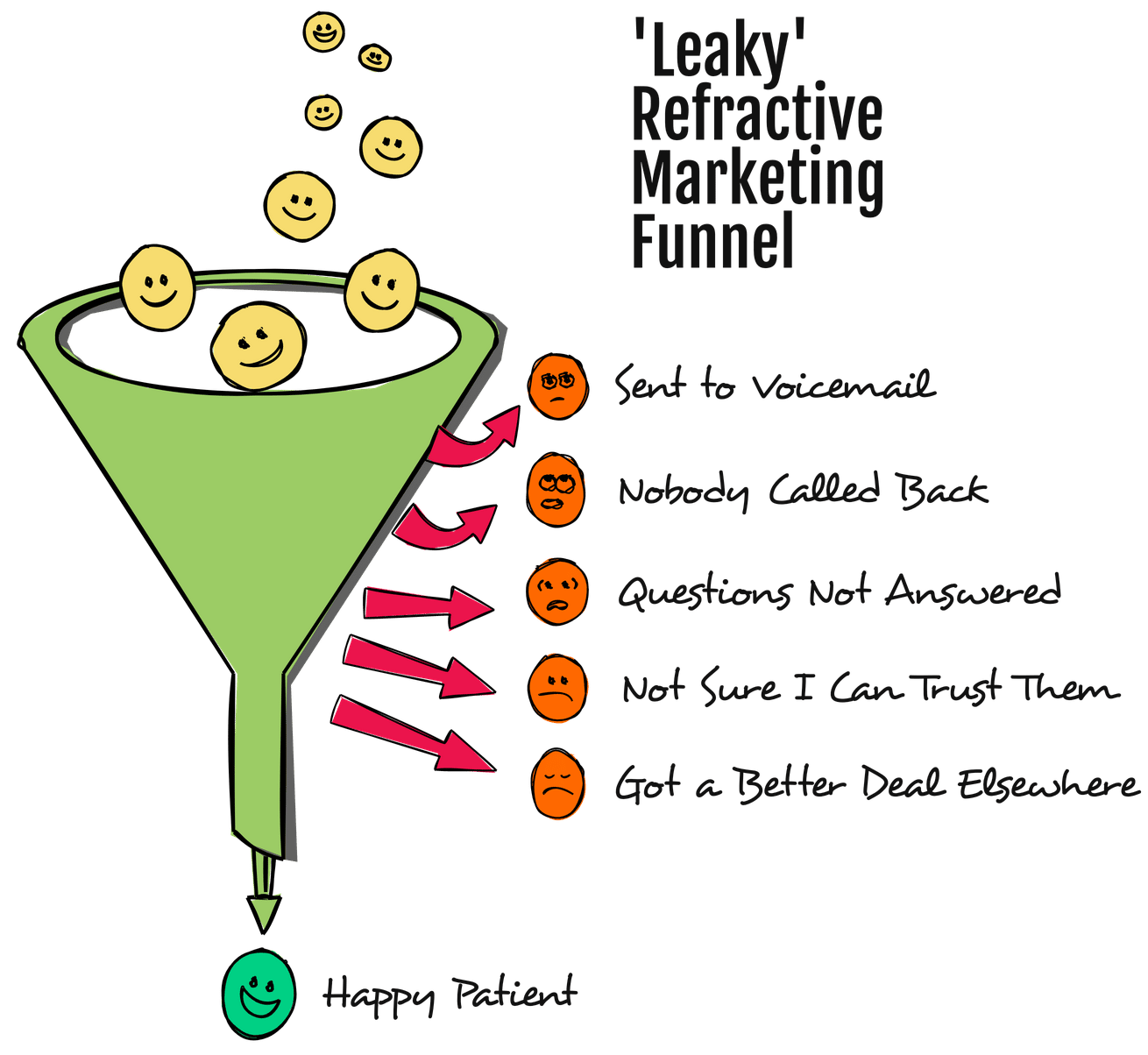
But with so many ‘opportunities’ for prospective patients to leak out of your marketing funnel, it soon becomes apparent why increasing the number of leads is NOT the first thing you should do in order to increase conversions, but rather the last.
For these reasons, I’ll show you why working backwards from the goal (surgery) instead of at the beginning (getting the initial phone call) can provide you with a better insight into what is happening in your LASIK (or other procedure or service) marketing funnel.
But first, my back story: I am a busy surgeon in a large multi-specialty practice, in a big retirement area, and we were trying to grow our LASIK revenue. I couldn’t figure out why our total number of LASIK cases had leveled off when our number of LASIK surgeons had doubled.
The main problem was that I didn’t know how many LASIK opportunities (that is, opportunities to convert leads to surgery) coming in were ‘lost.’ The phone was constantly ringing, so for a long time we never suspected how badly the LASIK book of business was declining. In the meantime, we had plenty of cataract surgery keeping us busy, so the problem kind of got neglected for a period.
When we finally started taking a deep dive, it began to dawn on us: How many calls never went anywhere? Did we have an actual count of the number of times we might have sold LASIK or cross-sold an alternative service (RLE or Cataracts when the caller was too old)? Again and again, the answer was no. The call center didn’t know. The Refractive Coordinator didn’t know. Not for sure. Not by looking them up in a prospect database.

Besides not knowing the number of opportunities, we also never knew the disposition of those inquiries. How many attempts were we actually making to connect and bring them in? Two? Three? Were we losing a case to another practice?
We had never explicitly instructed our staff on how many attempts to reconnect before abandoning a prospect as a lost opportunity. Nor had we specified how quickly they should reach out after a message was received. As you may or may not know, follow-up delays of over 3 hours for any new leads can amount to hefty opportunity loss, and not just for LASIK. Today’s callers want to hear from you ASAP since many will move on to your competitor if their questions cannot be answered in their first call.
Subjectively, I knew we'd done more surgeries in the previous 5 years with less surgeons in the practice. Unfortunately, there didn’t seem to be much interest in the drop off or its root cause because cataracts were keeping everyone crazy busy.
So I went rogue. I did a careful breakdown and process analysis of our LASIK marketing and sales funnel.
Then it came to me…
By mapping the entire end-to-end process, I realized we could execute a better process for capitalizing on LASIK phone inquiries. We could do it with assets we already had or could build in-house.
With zero additional advertising dollars!
No outside consultants or agency minions. No staff changes either. All I had to do was redesign the lead-capturing process and patch the holes through which our new LASIK opportunities were leaking. At the same time, I realized this was proof of the power of process documentation to not only improve our inbound LASIK marketing but also for other premium services as well.
It also became clear how valuable process maps were in aligning (and defining) all stakeholders - that’s everyone involved in the entire process no matter how small their role - BEFORE haphazardly running a campaign and cranking up expensive traffic generation with lots of advertising (after all, pouring more water into a leaky funnel will only result in a higher volume of leaking). I could foresee every aspect of a campaign BEFORE we invested one penny building it.
My plan was to begin with simple "as is” and "to be" maps showing where we were, along with the major steps needed to attain our goal of selling more LASIK. This result would be measured by not losing organic opportunities that were flowing in over the phone, regardless of how the caller found us. Discussing this initial map among our LASIK group would, hopefully, reveal who was/was not on board with the new process and whether we were in sync about the goal.
So I held an alignment meeting with all stakeholders.
The attendees included the process owner who managed LASIK sales along with all LASIK process participants and marketing staff in charge of LASIK. The alignment meeting produced a unanimous decision on the "big picture" of how the new process should flow and what we each had to contribute to make the desired change.
After that, we developed a process map to help us identify new marketing assets we might need as each prospect moved along their buying journey. We called this map our Production Blueprint. Each existing or new marketing asset was noted on the LASIK Marketing Map and the LASIK Sales Map. We named our process “LASIK C.A.P.P. (Capture All Phone Prospects)”.
Building on our successful documentation and alignment, we decided to look at applying it to marketing for other premium services in need of revenue growth.
Within 35 calendar days (not business days) of activating the new process, we had captured low-to-mid 6 figures in LASIK opportunities from inbound phone inquiries.
The Process Mapping Framework for Marketing Funnels
The marketing funnel process needs to be defined before it can be assembled using appropriate assets. So next I will lay out a repeatable framework for defining the marketing funnels your marketing operations team puts to use.
One caveat though: each marketing funnel is accompanied by a sales pipeline, something which we will cover in subsequent posts. For now, you need only understand that there is a handoff from marketing to sales in order for revenue to be realized.
The process-mapping framework has three steps. Each step has a map that builds detail upon the prior version. The reason for this iterative approach is that process participants (your staff and your managers) often have different ideas about what actually happens during a prospect’s buying journey.
Initially, in the first step, make a ‘Discovery’ map and sketch in broad strokes a process map showing the major milestones required to make the sale.
The second step, ‘Design and Align’, aligns process participants, process owners and executive sponsors around one single version of the truth about the prospect’s end-to-end buying experience. You will edit and expand the ‘Discovery Map’ during this step.
The third step, ‘Development’, is to produce a working blueprint from which marketing assets can be created by your agency or by your marketing department; for example: forms, pages, emails, ads, workflows, notifications, management reports and dashboards.
Let’s drill down:
Step 1) Discovery Map.
This is a high level map beginning with:
the interest shown by the prospect as they perform an activity that can be tracked (such as an inbound phone call)
the actions they take as they make their decision to choose you, and
the automated responses or personal follow-ups triggered by their activities.
Most agencies draw this as one funnel with three levels - TOFU (top of funnel), MOFU (middle of funnel), and BOFU (bottom of funnel). It is my opinion that you should not build one single funnel of three levels. Instead, you should build three individual funnels focused on the intent of each prospect as they move towards a decision:
TOFU is where prospects research their condition and available treatment.
MOFU is where they seek pricing and availability, practice preeminence, and outcomes.
BOFU is “the last mile” where a prospect reaches out and contacts the practice either by phone or online form and who is at this point 75% decided on whom to select.
Proper discovery takes each of these three buying stages apart and maps the prospect milestones as they transition from one level of readiness to the next.
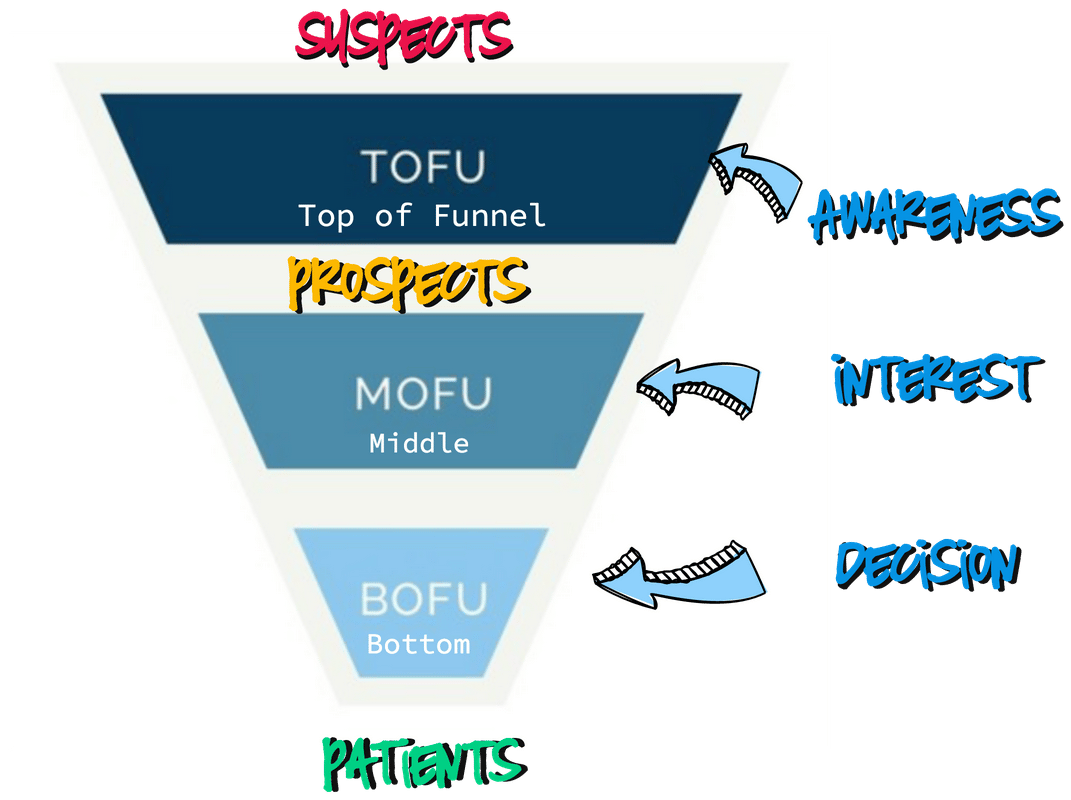
For the purpose of this discussion, I am only looking at the “last mile” (BOFU) where the prospect takes action and calls the practice.
The Discovery Map is a simple hand-drawn timeline of your “as-is” inquiry-handling process. The starting point is a sad face representing the patient’s unfulfilled need or want. The end-point is a happy face showing successful treatment. You and your team will mark each action that is taken by either the patient or your team starting with “inbound phone inquiry”.
What happens once the phone rings?
Then what happens?
For example, reception answers, transfers caller to coordinator voicemail, coordinator calls prospect back, appointment is scheduled, etc. One caveat though: it is important to make an honest assessment of what is actually happening, as opposed to what your staff believes is happening. That might require several ‘secret shopper’ calls just to be sure.
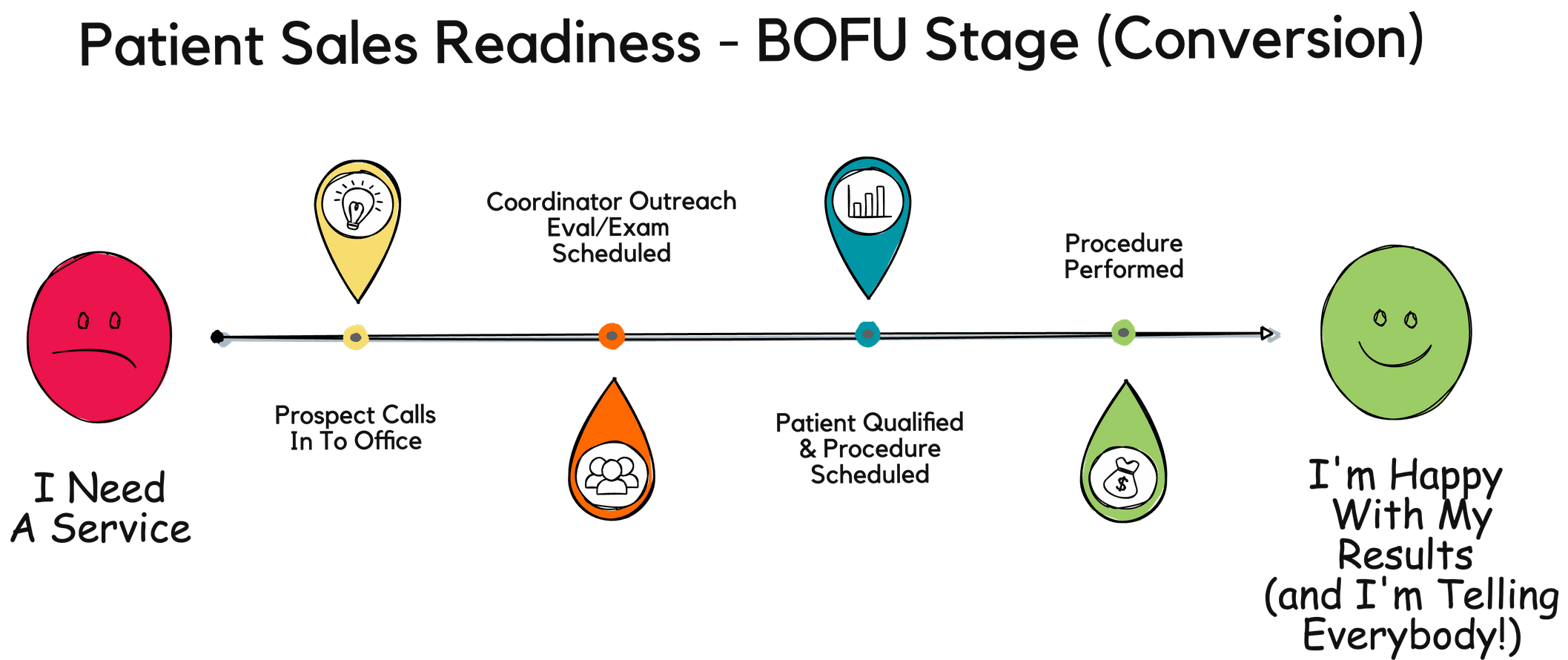
Discovery 'As-Is' Map
Once the stages have been articulated in this high level BOFU (Bottom of Funnel) Discovery Map, Step 2 is a deeper dive called Design.
Step 2) Design and Align
Design and Align is where the improved process, or “to-be” map is developed. The process your marketing operations wants done is captured in much greater detail. Think about new steps or interactions with the prospect that might positively influence their decision to choose you.
For example, you probably aren’t sending automatic email ‘indoctrination sequence’ follow-ups to every caller right now. So your design map will include this email ‘nurturing’ activity as an additional step on the timeline. Everything you believe should be done to draw the caller from “I’m interested” to “I’d like an eval/exam appointment” should be a milestone on the “to-be” map. The design step is your wishlist for improving your current, and possibly underperforming, conversion funnel.
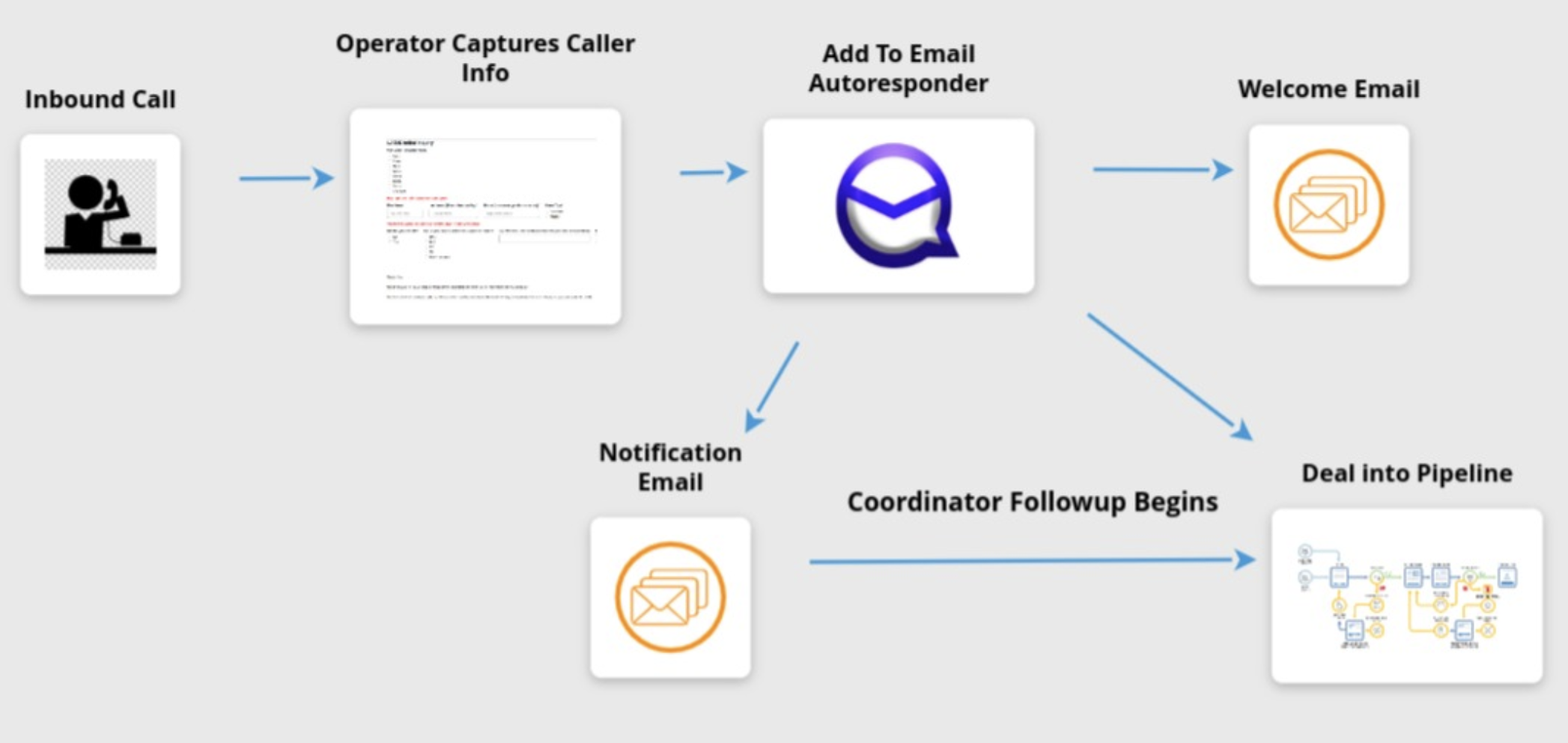
Design and Align 'To-Be' Map
Step 3) Development Map
The Development Map is an actual blueprint detailing every marketing asset and every workflow step that will be followed in your revised marketing funnel. For example, the phone rings and the operator captures the caller information. This triggers automatic and manual steps with different marketing assets as the flow progresses, from a welcome email sequence, to a phone follow-up decision tree, to a virtual visit qualification meeting, to an in-office evaluation. Assets could include emails, links to videos, patient guides, self-assessment, affordability calculators, etc.

Sample Development Map for LASIK Inquiry
And, In the End…
In summary, the only way to ensure your marketing investments produce the desired outcome is by mapping your “as-is” marketing and sales process, refine it to define your “to-be” marketing and sales process and then, and only then, commission marketing services to create it as the complete, end-to-end marketing funnel itself.
In context, the Design Map step is like the rendering or scale model an architect shows the owner. It is important because it aligns the vision for the project before any money is spent.
Then, in the Development Map step, the actual funnel is specified. By articulating each type of work product and marketing asset, it can serve to prevent needless expense. The Development Map helps identify the costs involved in “getting it running” and “keeping it running” (your funnel, that is). It should not be the first map you draw. Just as a builder requires a blueprint from an architect, the Development Map is the blueprint for building every operational marketing process. The Development Map is used to create scenarios with critical conversion points so you can ‘see’ what needs to happen in order to make a profit.
For those of you who are interested in maps I will email you PDF of the Design and Development Maps if you wish. Just Email info @ Emedikon.com, Subject: 'Maps', to request them.
